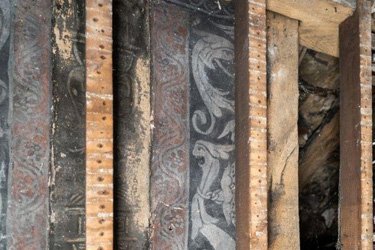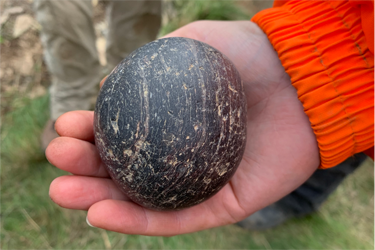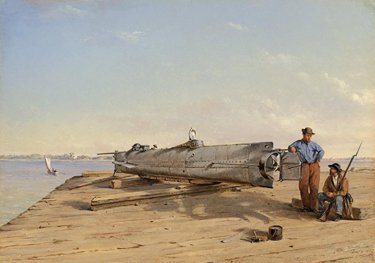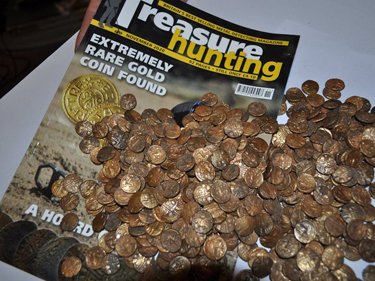Category Archive 'Archeology'
09 Nov 2021


Yorkshire Post:
Calverley Old Hall, between Leeds and Bradford, is currently subject to a major repair and renovation programme funded by the Landmark Trust, who have owned the building and run part of it as a holiday let since 1981.
The oldest parts of the hall date back to the 14th century but most of it is Tudor. It was the seat of the Calverley family for centuries until the 1750s, when they sold the estate and moved to Esholt Hall. Calverley Old Hall was then subdivided into cottages.
Ahead of the current restoration work, historians and conservation specialists were able to examine the fabric of the building and made an incredible discovery behind a 1930s fireplace. …
Dr Anna Keay, who worked at the site, said: “An exposed area of timber seemed to have something on it; reddish, greenish, and blackish stains on the oak. We thought they could just be the streaks and smudges of mould and dirt and decay. It looked to be wishful thinking that this was anything of note. But just on the off chance, ever cautious, we decided to ask the conservators at Lincoln Conservation to have a look. …
Two days were allocated… to remove the later plaster altogether and see how much remained beneath. I stopped in on the morning of day two, expecting them to have only just begun. When I walked up the stairs into the room I was simply overcome. The plaster had gone and there on all three walls before me was a revelation. Floor to ceiling, wall to wall, a complete, highly decorated Tudor chamber, stripped with black and red and white and ochre. Mythical creatures and twining vines, classical columns and roaring griffins.
“Wall paintings were prized in grand Tudor houses, and from time to time patches of them are revealed. But never in my own 27 years of working in historic buildings have I ever witnessed a discovery like this. Hidden panelling, yes, little snatches of decorative painting, once or twice. But an entire painted chamber absolutely lost to memory, a time machine to the age of the Reformation and the Virgin Queen, never. …
“Suddenly, we are transported from a dusty, dilapidated building into the rich and cultured world of the Elizabethan Calverleys, a well-educated family keen to display their learning and wealth by demonstrating their appreciation of Renaissance culture. The Calverley paintings are very carefully planned, in a vertical design that uses the timber studwork as a framework. Teethed birds laugh in profile; the torsos of little men in triangular hats sit on vases or balustrades. When the fantastical figures and architectural elements are incorporated into dense vertical stacks as at Calverley Old hall, they’re known as ‘candelabra.’
“The whole chamber was probably originally covered in the scheme, a rich, dark, private space that must have been all the more impressive by candlelight.”
RTWT
Wikipedia entry:
The hall was witness to dreadful violence in April 1605, when Walter Calverley murdered two of his sons, William and Walter, after drinking heavily. He was tried in York for murder, but refused to plead and was therefore pressed to death. Because of his refusal, his property could not be seized by the state, and passed to his surviving baby son. The murder inspired the Jacobean play A Yorkshire Tragedy, the authorship of which was attributed to William Shakespeare in the first printed edition (1608) but which is now thought to have been written by Thomas Middleton.
10 Oct 2021


Atlas Obscura:
If you sail to the island of Sanday in the Orkney archipelago in northern Scotland, you’ll see the silhouettes of neighboring islands on the horizon. Upon arrival you’ll see white, sandy beaches that trail into rough, once-agricultural terrain, and experience its erratic weather—sun then fog then rain then clear skies all in the same day. Nestled there, on a shallow cliff, is a mound of earth and rocks: a prehistoric tomb dating to around 3500 B.C.
The tomb sits on a low-lying peninsula, where growing storms and agitated seas are eroding it away. So, in August and September 2021, a group of archaeologists made their way there, to Tresness, the site of that lone Neolithic tomb, with their sights set on excavation. The research team was anxious to study the tomb before it was lost; it contains a single chamber, presumably for someone important.
“What we discovered was an exceptionally well-preserved monument,” says Hugo Anderson-Whymark, a curator of prehistory at National Museums Scotland who co-led the research. There were no remains, but inside the monument were a couple rare finds: two polished stone balls, each about the size of a tennis ball.
The other leading archaeologist of the excavations, Vicki Cummings of the University of Central Lancashire, unearthed both of the orbs herself. With the first, she remembers pulling her trowel back and immediately noticing that something was different. “It was really exciting,” she says. “I said after the first one, ‘I’ll never find anything like that ever again in my career,’ and then I found another one. It’s very rare that you would find two such amazing objects, it was incredible.”
But these two balls aren’t exactly a unique find—they’re part of a widely distributed mystery left by the Neolithic inhabitants of the British Isles. More than 500 stone balls like them have been discovered to date. For centuries, no one paid them much attention. Farmers or builders would randomly discover them in fields, and then either keep them or donate them without another thought. It wasn’t until archaeologist Sir Daniel Wilson published illustrations of the orbs in 1851 that people began to take notice. “Suddenly you saw, from 1850 onwards, lots of them coming out the woodwork,” says Anderson-Whymark. “There were about 100 known by the early 20th century.” But because of the way that many of them were found—without archaeological context—scholars didn’t know where most came from. That’s why Cummings was so floored by what she found. Discovering not one but two, in their original location in a tomb, is incredible—only a few have ever been found in their original context. Also, most of the 20 balls that have been found in the Orkney Islands are carved and etched with patterns and designs. These, on the other hand, were polished smooth.
RTWT
Clearly, those Neolithic fellows played some game of the Boules family resembling Lawn Bowls, Raffe, Boules, Bocce, or Péntaque.
30 Aug 2021


Dere was an old prophesy found in a bog,
Lilliburlero, bullen a la.
–Traditional Song
Not a prophecy, this time, but rather the very sort of heathen idol/primitive art masterpiece noteworthily destroyed by St. Patrick in the course of his conversion of Ireland. MSN.com:
A wooden idol that just predates St. Patrick’s arrival in Ireland more than 1,000 years ago has been unearthed from a bog that archaeologists think may have been a sacred ritual site. Researchers say the figure could represent a pagan deity.
The wooden figure rests on a tarp.© Archaeological Management Solutions The wooden figure rests on a tarp.
Made from a split oak trunk, the figure has a human head and several notches along its body. According to researchers, a dozen similar idols have been discovered in Ireland. This recent find is the tallest, stretching over eight feet.
Full animal skeletons — including at least 10 prehistoric dogs — and a bone-handled ritual dagger were also found in the bog, which researchers say suggests the wetlands may have been used for animal sacrifice ceremonies in which the idol could have been involved. Wooden cauldrons and human remains, including cranial fragments from at least four people, were also uncovered.
“We realized what we had essentially is a sacred bog where over millennia, people were depositing objects or idols,” said Eve Campbell. She is an archaeologist with the independent consultancy, Archaeological Management Solutions, who directed the excavation.
In prehistory, bogs were seen as sacred spaces where people could contact ancestors, spirits or gods — and sometimes as portals between worlds. Luckily for researchers, these spaces’ wetland conditions helped preserve ancient wood.
“They’re not quite land, not quite water, they have this wonderful reflective quality,” Campbell said. “If you think about a time before mirrors, there’s something very magical about these still waters where everything is reflected back.”
WT (Ignore the gender nonsense.)
04 Aug 2021


Conrad Wise Chapman, “Submarine Torpedo Boat H.L.Hunley, Dec. 6,1863, American Civil War Museum, Richmond.
The Civil War Picket reports that scientists at a Clemson University Conservation Center have learned a great deal about the clothing and personal effects of Captain George E. Dixon and the rest of the 8-man crew of the C.S.S. Hunley. Dixon was evidently well-to-do and a sharp dresser, wearing a cashmere coat on that fatal evening.
On Feb. 17, 1864, H.L. Hunley made history by becoming the first submarine to sink an enemy warship. The 40-foot iron vessel — bullets pinging off its iron exterior — planted a torpedo in the hull of the Union ship USS Housatonic, setting off a charge that sent the Federal vessel and five crew members to the sandy bottom within minutes.
The Hunley disappeared beneath the waves and entered the realm of legend. To this day, historians, scientists and others debate what caused it to end up on the ocean floor. Discovered a few miles off Charleston in 1995, and raised in 2000, the Hunley is being conserved at Clemson University’s Warren Lasch Conservation Center in North Charleston.
Experts have been analyzing the incredible array of artifacts found inside the submarine and are now working on a volume about the crew, including personal effects such as clothing, buttons and shoes. They hope to have the volume, which they are preparing for the U.S. Navy, finished later this year.
“The Hunley as a crew did not have a set uniform at all. They wore what they were comfortable or what they were used to,” said Nick DeLong, maritime archaeologist at the center. Six of the eight wore something that was part of a military uniform.
RTWT
15 Feb 2021


The Guardian reports on an interesting new discovery concerning Stonehenge.
An ancient myth about Stonehenge, first recorded 900 years ago, tells of the wizard Merlin leading men to Ireland to capture a magical stone circle called the Giants’ Dance and rebuilding it in England as a memorial to the dead.
Geoffrey of Monmouth’s account had been dismissed, partly because he was wrong on other historical facts, although the bluestones of the monument came from a region of Wales that was considered Irish territory in his day.
Now a vast stone circle created by our Neolithic ancestors has been discovered in Wales with features suggesting that the 12th-century legend may not be complete fantasy.
Its diameter of 110 metres is identical to the ditch that encloses Stonehenge and it is aligned on the midsummer solstice sunrise, just like the Wiltshire monument.
A series of buried stone-holes that follow the circle’s outline has been unearthed, with shapes that can be linked to Stonehenge’s bluestone pillars. One of them bears an imprint in its base that matches the unusual cross-section of a Stonehenge bluestone “like a key in a lock”, the archaeologists discovered.
Mike Parker Pearson, a professor of British later prehistory at University College London, told the Guardian: “I’ve been researching Stonehenge for 20 years now and this really is the most exciting thing we’ve ever found.”
The evidence backs a century-old theory that the nation’s greatest prehistoric monument was built in Wales and venerated for hundreds of years before being dismantled and dragged to Wiltshire, where it was resurrected as a second-hand monument.
Geoffrey had written of “stones of a vast magnitude” in his History of the Kings of Britain, which popularised the legend of King Arthur, but which is considered as much myth as historical fact.
Parker Pearson said there may well be a “tiny grain” of truth in his account of Stonehenge: “My word, it’s tempting to believe it … We may well have just found what Geoffrey called the Giants’ Dance.”
The discovery will be published in Antiquity, the peer-reviewed journal of world archaeology, and explored in a documentary on BBC Two on Friday presented by Prof Alice Roberts
RTWT
It may be that the British policy of relocating antiquities like the Elgin Marbles goes back farther than anyone ever realised.
04 Jan 2021


Smithsonian reports on another British coin hoard. Metal detectors really work, don’t they?
This September, a British birder who’d stopped on the edge of a farmer’s field to watch a buzzard and a pair of magpies stumbled onto a trove of 2,000-year-old Celtic coins worth an estimated £845,000 (around $1,150,000 USD).
As first reported by Julian Evan-Hart of Treasure Hunting magazine, the unnamed bird-watcher—who is also an amateur metal detectorist—unearthed the stash of some 1,300 gold coins in a field in the eastern English countryside. Dated to between roughly 40 and 50 A.D., the cache is the largest hoard of Iron Age Celtic coins found in the United Kingdom since 2008, when a car mechanic excavated a stash of 850 ancient staters, or handmade money, in Suffolk.
“I saw the glint of gold and realized it was a beautiful Celtic gold stater, which made me sit down in sheer shock,” the birder tells Treasure Hunting, as quoted by the Daily Mail’s Luke May. “I then spotted the second coin two feet away and rushed home to get my [metal detector].”
Upon his return, the man found that his detector produced a “really strong” signal—a sure sign that more treasures lingered below the surface. Digging down about 18 inches, he extracted a copper vessel brimming with gold coins dated back to the era when Celtic queen Boudica led a massive uprising against the Romans.
“I had to sit down to get my breath back,” the treasure hunter says. “I had only come out for a walk and found a Celtic hoard.”
Once the man overcame his initial shock, he filled two large shopping bags with the cache of coins and returned home. Then, he promptly contacted local authorities to report the find. If experts deem the discovery treasure, they will offer it to a museum and potentially offer a share of the reward to the finder. (Current guidelines define treasure very narrowly, but as Caroline Davies reports for the Guardian, the U.K. government is working to expand these parameters in order to better protect the country’s national heritage items.)
“The coins form a substantial if not enormous contribution to our academic numismatic knowledge and will undoubtedly be subject to much assessment over the coming year,” says Jules Evan-Hart, editor of Treasure Hunting, in a statement quoted by the New York Post’s Hannah Sparks. “It is possible that [the coins] may form a deposit as a ‘war chest’ for Boudica’s eastern campaigns.”
RTWT
Your are browsing
the Archives of Never Yet Melted in the 'Archeology' Category.
/div>

Feeds
|
